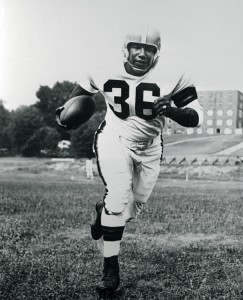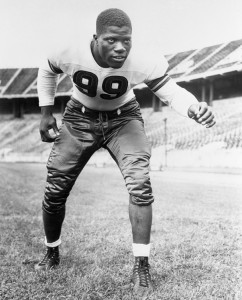Black History Month: Breaking Football’s Color Barrier
Monday, February 22nd, 2021February is Black History Month, an annual observance of the achievements and culture of Black Americans. This month, Behind the Headlines will feature Black pioneers in a variety of areas.
Today, many Black football players are in the National Football League (NFL). But, this was not always the case. Black players had played in the early history of professional football, but all had been forced out by 1934. This changed in 1946, when the Cleveland Browns teammates Marion Motley (1920-1999) and Bill Willis (1921-2007) became two of a handful of players who permanently broke football’s color barrier, opening professional football to Black players.
Marion Motley was born June 5, 1920, near Albany, Georgia. He grew up in Canton, Ohio, where he attended Canton McKinley High School. Motley attended South Carolina State College, a historically Black college, in 1939. He then played for the University of Nevada, Reno, from 1940 to 1942. In Reno, Motley played fullback on offense, linebacker on defense, and kick returner. According to local accounts, he was also a skilled kicker and passer.
Motley joined the U.S. Navy in 1944 and was stationed at Naval Station Great Lakes near Chicago, Illinois. There, he played football under head coach Paul Brown.
In 1946, the Cleveland Browns began play as part of the All-America Football Conference (AAFC), a rival to the NFL. Paul Brown, Motley’s coach at Great Lakes, was named head coach and general manager. Brown recruited Motley to the new team. Motley anchored the powerful offense alongside quarterback Otto Graham. The Browns dominated the AAFC, winning championships all four years of the league’s existence.
Motley played fullback during his professional career. He was agile enough to dodge defenders, but he was also strong enough to break tackles. He did not shy away from hits and often ran defenders over.
In 1950, the Browns and two other teams from the AAFC joined the NFL. That year, Motley led the NFL with 810 rushing yards and was named to the Pro-Bowl team. The Browns went on to win the 1950 NFL championship game.
Motley was plagued by injuries in his later career, likely the result of his aggressive style of play. Motley left the Browns before the 1954 season and was later traded to the NFL Pittsburgh Steelers. He appeared with the Steelers in a few games in 1955 before retiring. He was elected to the Pro Football Hall of Fame in 1968. Motley died on June 27, 1999, in Cleveland.
William Karnet Willis was born on Oct. 5, 1921, in Columbus, Ohio. He attended East High School. He then enrolled at Ohio State University, where he played under head coach Paul Brown. The Buckeyes won their first national championship in 1942. Willis was named to the All-American team in 1943 and 1944, his senior year.
In 1946, when the Cleveland Browns began play as part of the AAFC, Willis’s college coach Paul Brown recruited Willis to the new team. With Willis anchoring the defense, the Browns won all four AAFC championships.
Willis played middle guard, a position similar to middle linebacker in modern defensive play. He chose to play this position despite being relatively small for a defensive player, at 6 feet 2 inches (1.9 meters) and 213 pounds (96 kilograms). Despite his size, he became one of the most feared defensive players due to his exceptional quickness and strong tackling ability.
When the Browns and two other teams from the AAFC joined the NFL in 1950, Willis’s speed saved the Brown’s season during a playoff game against the New York Giants. On a play in which the Giants running back had broken away from the defense and was heading for the end zone, Willis chased him down and tackled him at the 4 yard-line. The play preserved Cleveland’s victory, and the Browns went on to win the 1950 NFL championship game.
Willis was named to three NFL Pro-Bowl teams. He retired after the 1953 season and was inducted into the Pro Football Hall of Fame in 1977. Willis died Nov. 27, 2007, in Columbus.




